Front Seats
To prevent serious injury or death:
-
Never attempt to adjust the seat while the vehicle is moving. The seat could respond with unexpected movement and may cause loss of vehicle control resulting in a collision.
-
Do not place anything under the front seats. Loose objects, including unsecured floor mats, in the driver’s foot area could interfere with the operation of the foot pedals.
-
Do not allow anything to interfere with the normal position and proper locking of the seatback.
-
Do not place a cigarette lighter on the floor or seat.
-
Use extreme caution when picking up small objects trapped under the seats or between the seat and the center console. Your hands might be cut or injured by the sharp edges of the seat mechanism.
-
If there are occupants in the rear seats, be careful while adjusting the front seat.
-
Make sure that the seat is locked in place after the adjustment. If not, the seat might move unexpectedly.
Sitting in a reclined position when the vehicle is moving can be dangerous. Even when buckled up, the effectiveness of the restraint system (seat belts and/or airbags) is greatly reduced by reclining your seatback.
Seat belts must be snug against your hips and chest to work properly.
The more the seatback is reclined, the greater the chance for the passenger’s hips to slide under the lap belt or the passenger’s neck to strike the shoulder belt.
Never ride with a reclined seatback when the vehicle is moving.
Riding with a reclined seatback increases your chance of serious or fatal injuries in the event of a collision or sudden stop.
Driver and passengers should always sit well back in their seats, properly belted, and with the seatbacks upright.
Seat belts must be snug against your hips and chest to work properly. When the seatback is reclined, the shoulder belt cannot do its job because it will not be snug against your chest. Instead, it will be in front of you. During a collision, you could be thrown into the seat belt, causing neck or other injuries.
The more the seatback is reclined, the greater chance the passenger’s hips will slide under the lap belt or the passenger’s neck will strike the shoulder belt.
The front seat can be adjusted by using the levers located underneath the front part of the seat or on the outer side of the seat.
Forward and rearward adjustment
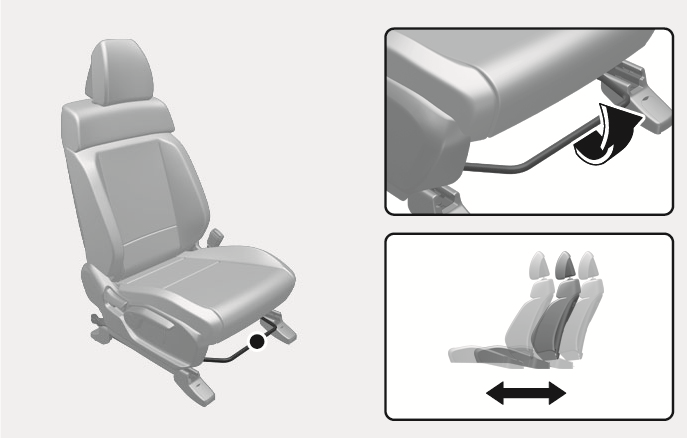
2C_AdjustSeatForwardBackwardmanual
To move the seat forward or rearward:
-
Pull up the seat slide adjustment lever and hold it.
-
Slide the seat to the desired position.
-
Release the lever and make sure the seat is locked in place. Move forward and rearward without using the lever. If the seat moves, it is not locked properly.
Seatback angle adjustment
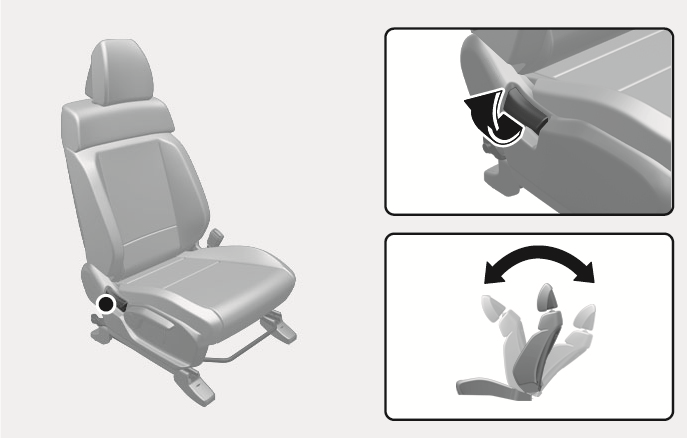
2C_AdjustSeatBackmanual
To recline the seatback:
-
Lean forward slightly and lift up the seatback lever.
-
Carefully lean back on the seat and adjust the seatback to the desired position.
-
Release the lever and make sure the seatback is locked in place.
Seat height adjustment
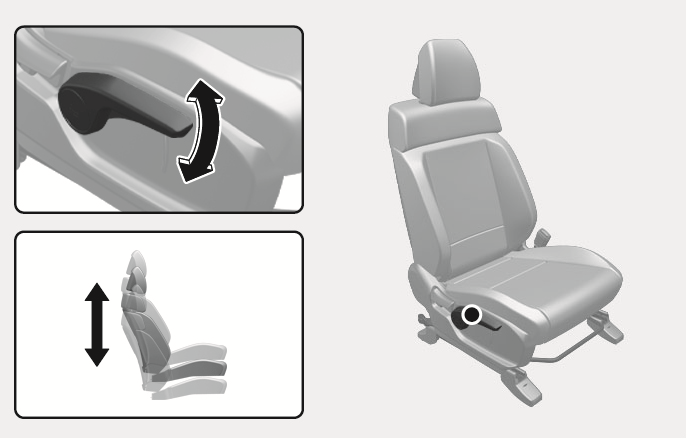
2C_AdjustSeatHeightmanual
To change the height of the seat:
-
Push down on the lever several times, to lower the seat.
-
Pull up on the lever several times, to raise the seat.
The front seat can be adjusted by using the control switches located on the outside of the seat cushion.
Never allow children to remain in the vehicle unattended. The power seats are operable when the vehicle is turned off.
To prevent damage to the seats:
-
Always stop adjusting the seats when the seat has been adjusted as far forward or rearward as possible.
-
Do not adjust the seats longer than necessary when the vehicle is turned off. This may result in unnecessary battery drain.
-
Do not operate two or more seats at the same time. This may result in an electrical malfunction.
Forward and rearward adjustment
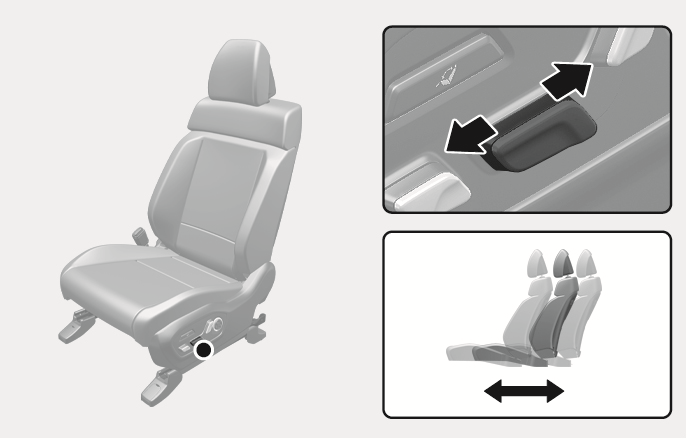
2C_AdjustSeatForwardBackwardAuto
To move the seat forward or rearward:
-
Push the control switch forward or rearward.
-
Release the switch once the seat reaches the desired position.
Seatback angle adjustment
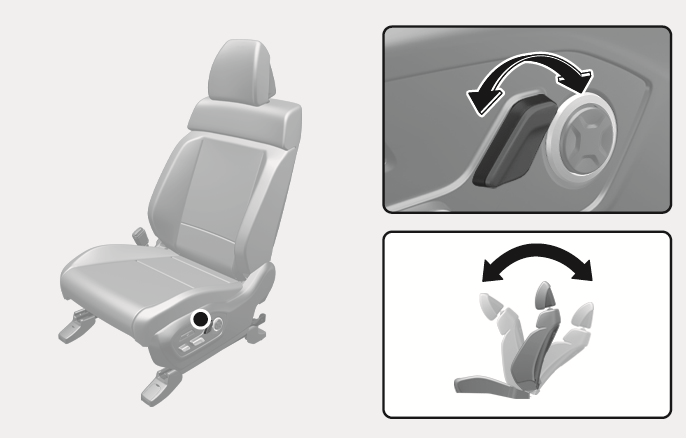
2C_AdjustSeatBackAuto
To recline the seatback:
-
Push the control switch forward or rearward.
-
Release the switch once the seatback reaches the desired position.
Seat cushion tilt/Seat height adjustment
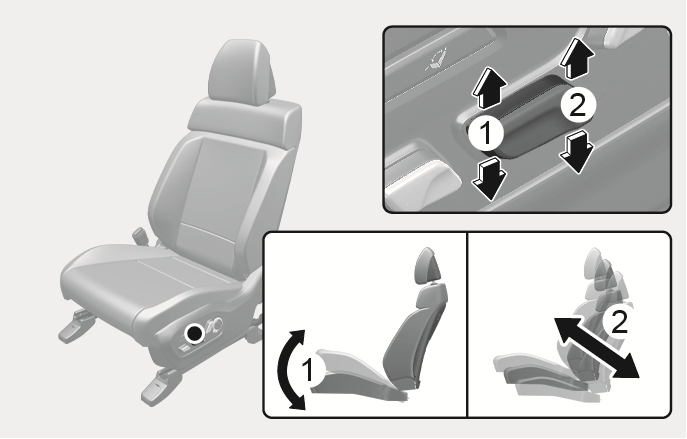
2C_AdjustSeatHeightAuto
-
Seat cushion tilt (1)
To change the angle of the front part of the seat cushion:
-
Push the front portion of the control switch up to raise or down to lower the front part of the seat cushion.
-
Release the switch once the seat reaches the desired position.
-
Seat height (2)
To change the height of the seat:
-
Push the rear portion of the control switch up to raise or down to lower the height of the seat.
-
Release the switch once the seat reaches the desired position.
Lumbar support (for driver’s seat)
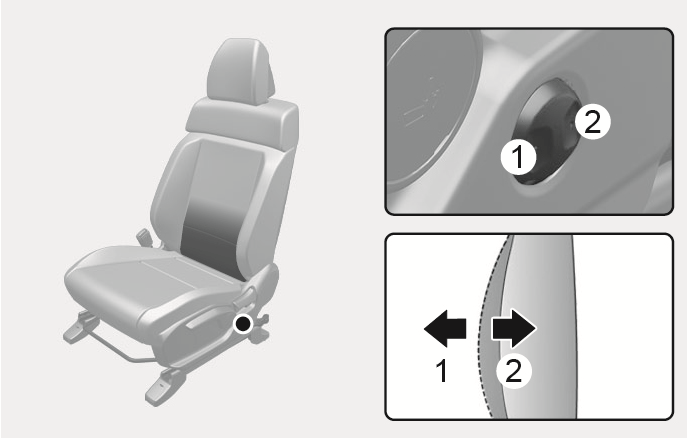
2C_AdjustSeatBackCushionAuto_1
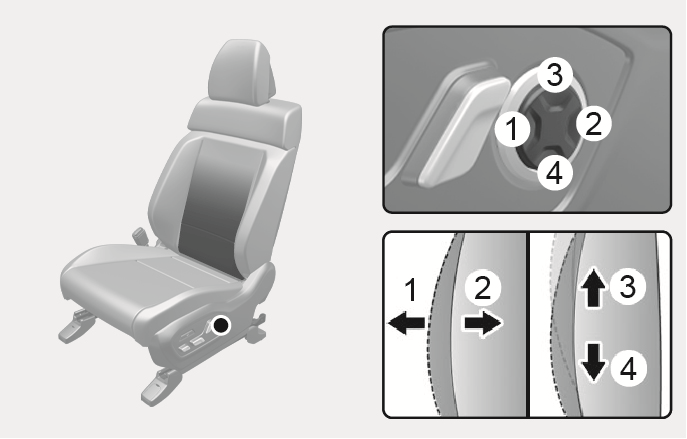
2C_AdjustSeatBackCushionAuto
To adjust the lumbar support (Type A):
-
The lumbar support can be adjusted by pressing the lumbar support switch.
-
Press the front portion of the switch (1) to increase support or the rear portion of the switch (2) to decrease support.
To adjust the lumbar support (Type B):
-
Press the front portion of the switch (1) to increase support or the rear portion of the switch (2) to decrease support.
-
Press switch (3) or (4) to move the support position up or down.
-
Release the switch once the lumbar support reaches the desired position.
Do not continue to operate the lumbar support when the lumbar support provides its maximum support. Damage to the lumbar support motor could occur.
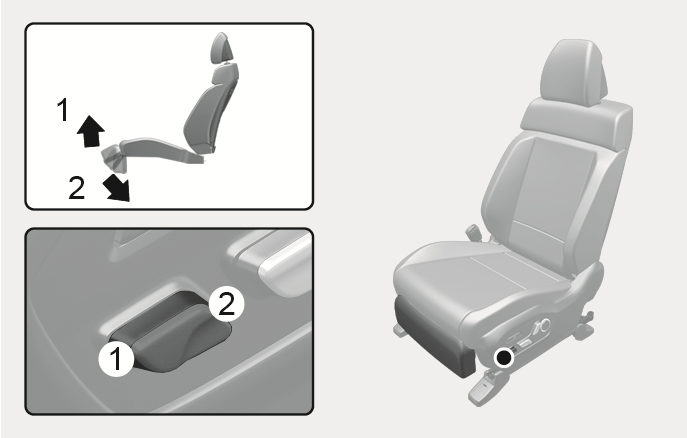
2C_LegSupportCautionAdjust
Push the control switch forward (1) to raise the leg support.
Push the control switch rearward (2) to lower the leg support.
-
When lowering or raising the Leg support, be careful not to have your hands or legs caught under the front seats or other surrounding parts of the Leg support. Unexpected injuries may occur.
-
Do not allow children to adjust the switch. Unexpected injuries may occur.
-
Make sure that the leg support do not interfere with each other while adjusting. The body parts or objects may be damaged if it is caught in the interference.
Do not sit or place heavy objects on the Leg support. It may damage the system.
The driver's leg support can be raised only when the gear is in P (Park) or when the vehicle speed is below 3 mph (5 km/h).
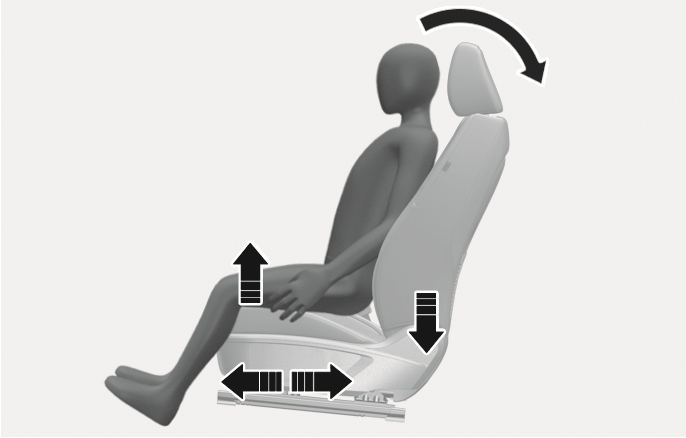
2C_RelaxationComfortSeatOperation
Relaxation comfort seats help distribute body pressure and concentrated weight on specific body parts that occur while sitting in the same position for a long period of time. The seat helps relieve fatigue and discomfort by providing the optimal sit position.
Press the auto return button to return to the original seat position after operating the Relaxation comfort seat.
Using the seat adjustment switch other than the auto return button may restrict the downward cushion movement.
Take the following precautions when using the relaxation comfort seat:
-
Do not use the relaxation comfort seat while the vehicle is moving. Using the comfort seat could increase the risk of injuries in the event of a collision or sudden stop.
-
Do not use the relaxation comfort seat when the luggage or other objects are placed at the rear seat.
-
Do not use the relaxation comfort seat while the vehicle is moving. Seat belts may not operate normally due to the lack of adherence between the shoulder belts and the body.
-
Do not use the relaxation comfort seat when the rear seats are not in the rearmost position and upright.
Using the relaxation comfort seat
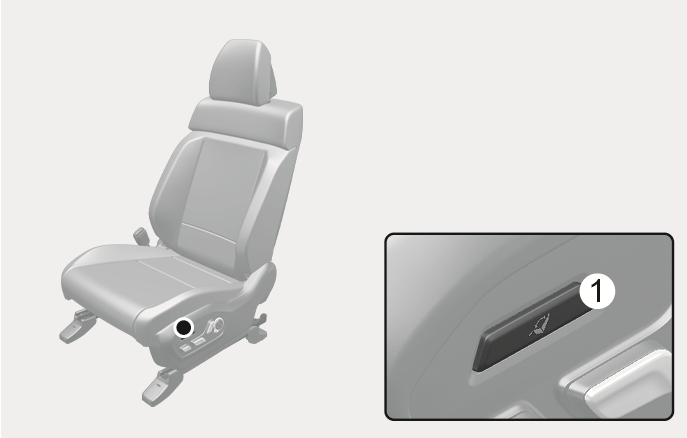
2C_RelaxationComfortSeatSwitch
To activate relaxation comfort seat
Press the switch (1) for more than 0.5 seconds while satisfying the relaxation operating conditions. The seat moves to the relaxation position.
When relaxation comfort seat is activated:
-
The seat cushion moves forward or rearward automatically.
-
The seat cushion and seatback angle are adjusted.
In the following situation, an alarm appears when the infotainment system is on and the relaxation comfort seat deactivates.
-
When the gear is not in P (Parking).
-
When the vehicle is moving more than 1.8 mph (3 km/h).
-
When the rear seat belt is fastened.
You can adjust the seat by using the seat adjustment switches.
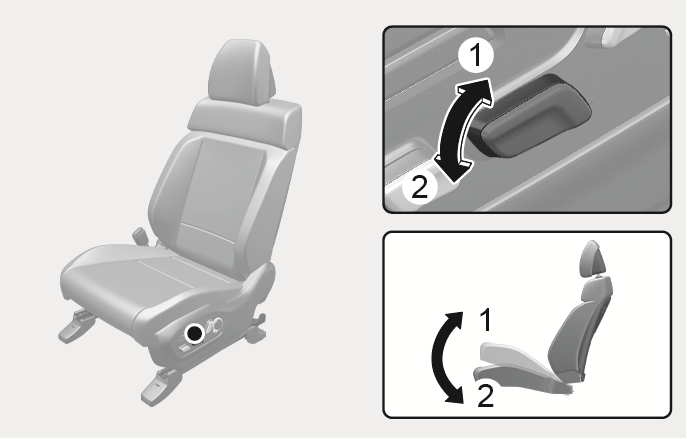
2C_RelaxationComfortSeatAdjustCushion
-
Pull up the front of the switch (1) to adjust the cushion to the desired position.
-
Push down front of the switch (2) to adjust the cushion to the desired position.
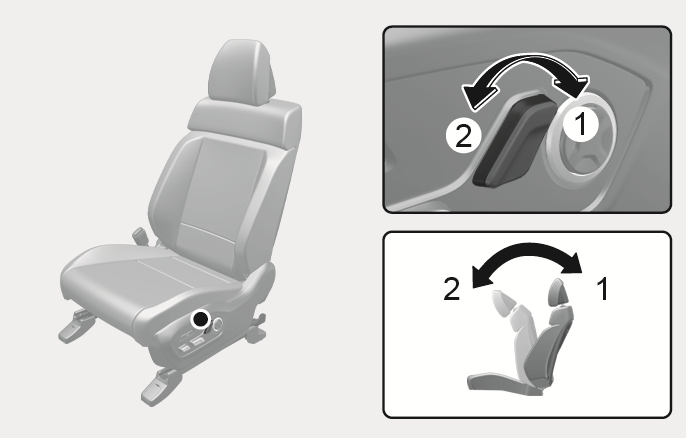
2C_RelaxationComfortSeatAdjustBack
-
Pull the upper part of the switch rearward (1) to adjust the seat back to the desired position.
-
Push the upper part of the switch forward (2) to adjust the seat back to the desired position.
Even when the relaxation comfort seat is operated by others, the additional adjustment is possible by pressing relaxation comfort seat switches.
Returning to the original seat position
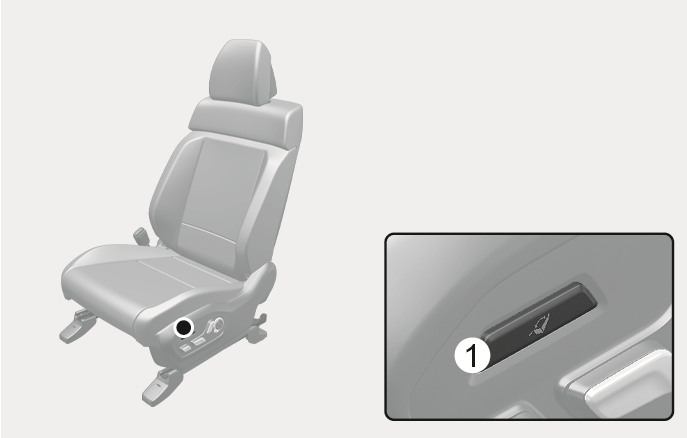
2C_RelaxationComfortSeatReturnSwitch
Press the front portion of the switch (1) for more than 0.5 seconds while the seat is in the relaxation comfort seat position, the seat return backs to the original position.
-
The driver seat returns to the original position when the gear was in P (Park).
In the following situation, the relaxation comfort seat does not return to the original position.
-
When the gear is not in P (Park).
-
When the vehicle speed is above 1.8 mph (3 km/h).
-
When the driver's seat Integrated Memory System is reset. (if equipped)
When relaxation comfort seat cannot be operated, reset the Integrated Memory System. If relaxation comfort seat does not operate even after resetting the Integrated Memory System, contact an authorized HYUNDAI dealer.
Do not use the seat switches simultaneously. It may damage the seat system.
Resetting the Relaxation mode
Refer to the "Integrated memory system" section in chapter 5.
If resetting stops before before the process is complete, restart the resetting procedure. The use of Relaxation mode may be limited if resetting has not been completed.
After resetting is completed, adjust the seat to the desired position.
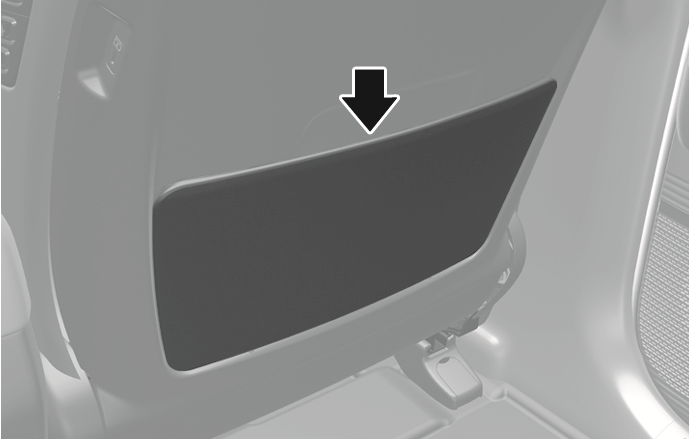
2C_SeatBackPocket
The seatback pocket is provided on the back of the front seatbacks.
Do not put heavy or sharp objects in the seatback pockets. In a collision, they could come loose from the pocket and injure occupants.